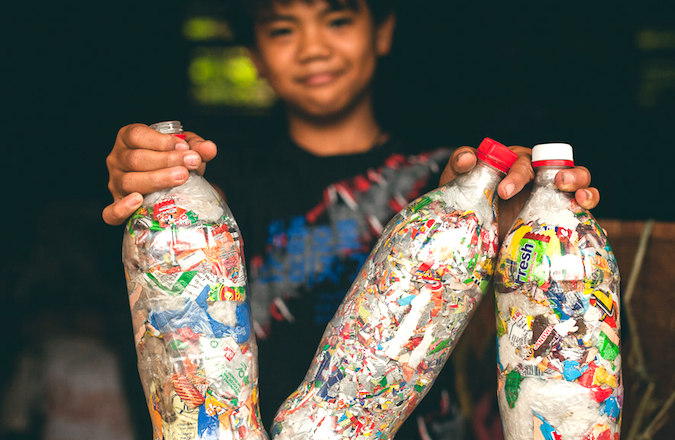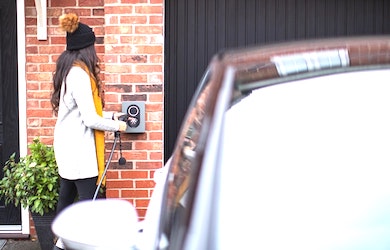Ecobricking is a phenomenon that began as a result of a variety of local initiatives in various parts of the world, in reaction to the perceived difficulty of managing plastic waste. [1] The official Ecobricks website defines Ecobricks as “…a simple, low-tech, non-capital, plastic transition technology that follows the Earth’s example of carbon care.” [2] This is achieved by getting a polyethylene terephthalate (PET) bottle and packing it solid with clean and dry used plastic. Once the bottles are packed tight with layers of unwanted plastic, they become strong enough to be used as building materials.
Figure 1: A student in Bontoc, Northern Philippines proudly holds his Ecobricks.
Construction of an Ecobrick
Any size transparent PET plastic bottle can be used to make standard Ecobricks. To fill the Ecobricks, plastic can be shredded or sliced into small bits; anything from food wrappers to shopping bags to packaging can be used. Both the bottle and the packed plastic are dry and clean, preventing bacteria from growing inside the Ecobrick. Ecobrickers will hand pack the layers of unwanted plastic into the bottle with a wooden or bamboo stick. When the Ecobricks are packed solidly with no holes or gaps, they may support a person’s weight and be used in construction projects.
Aside from the standard Ecobricks explained above, more obscure fillings include:
- Cigbricks – Completed using plastic/acetate cigarette filters
- Ocean Ecobricks – Using plastic collected from beaches, oceans and rivers.
Short Term Use
Once multiple Ecobricks are available, they can be put to short-term use in a large range of scenarios, these include:
- Modular Units, also known as “Milstein Modules”
- Lego-Furniture and
- Open Spaces
Milstein Modules are the quickest, simplest, and possibly most enjoyable way to use Ecobricks. Milstein Modules are similar to LEGO, and have been used by Ecobrickers all over the world to create horizontal surfaces, such as tables, beds, and benches. A minimum of 12 Ecobricks of the same form and size are joined together in a triangular module to construct a robust building block to make a Milstein Module. These modules can then be duplicated, layered, and exponentially multiplied to build furniture and even structures.
Long Term Use
Ecobrick can also be put to long-term use in earthen gardens and structures. The natural construction traditions of our ancestors inspired the Earth and Ecobrick building technologies. By adapting the building methods of our ancestors and maintaining the core principles, we can put Ecobricks to good use. Earth construction makes use of local building elements such as sand, clay, wood, and grasses, reducing the need for long-distance shipping. This can then be utilised with Ecobricking, as they use the materials available to us as the foundation for the construction process.
Many communities are already utilising Ecobricks in their garden structures, such as wells, garden walls and seating areas. Once Ecobricks are mixed with the earth and an organic binder such as straw or hay is added, durable structures can be erected.
The Future of Ecobricks
The Ecobrick movement is only just getting started, with Ecobrickers everywhere developing new and exciting ways to use Ecobricks. I for one am excited to see what is next for this innovative movement.
About Pager Power
Pager Power undertakes technical assessments for developers of renewable energy projects and tall buildings. For more information about what we do, please get in touch.
References
[1] Webb, H., Arnott, J., Crawford, R. and Ivanova, E., 2012. Plastic Degradation and Its Environmental Implications with Special Reference to Poly(ethylene terephthalate). Polymers, 5(1), pp.1-18.
[2] Ecobricks.org. 2022. Ecobrick Powered Plastic Transition | Ecobricks.org. [online] Available at: https://www.ecobricks.org.
[3] Chan, J. and Christie, I. (August 2013) from WikiCommons. Last accesses on 15th June 2022. Available at: https://commons.wikimedia.org/wiki/File:Ecobricks-are-bottles-packed-with-non-biological-waste.jpg




